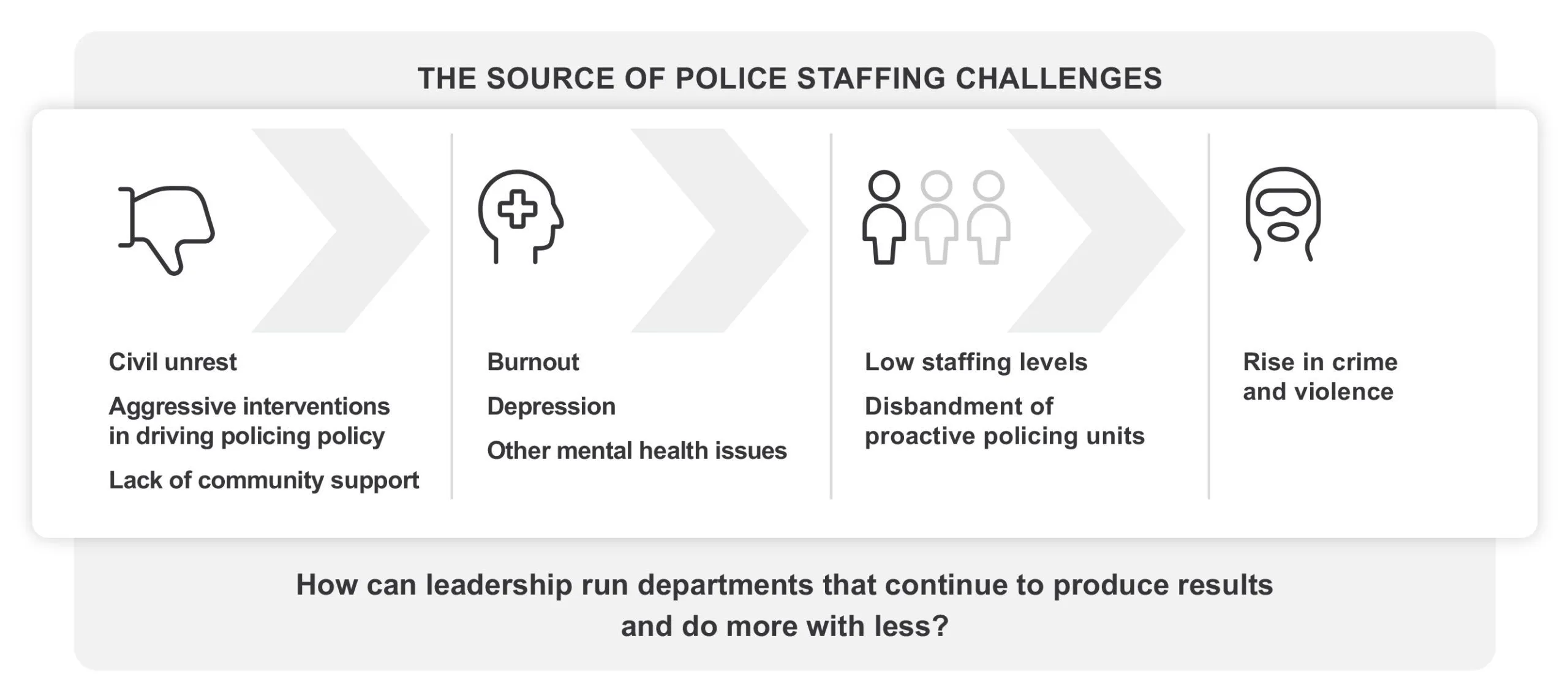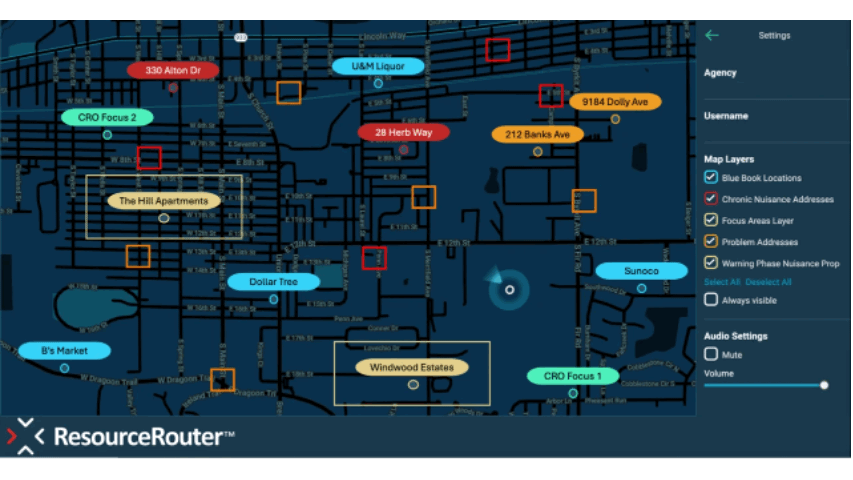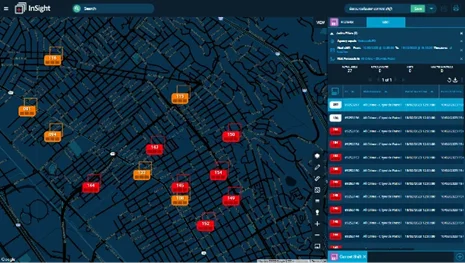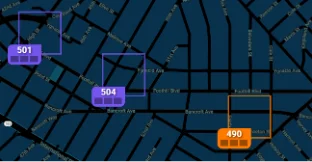A June 2021 survey, by the Police Executive Research Forum (PERF), of about 200 police departments reflected a resignation rate up 18 percent between April 2020 and March 2021 compared with the year prior, while retirements rose 45 percent. In major cities all over the U.S, from Minneapolis to Portland, police departments are struggling under the weight of chronic staffing shortages. How did we get here?
Understanding the Source of Police Staffing Challenges
There are several factors in recent years that have contributed to police officers leaving the force. Civil unrest, perceived aggressive interventions by elected officials in driving policing policy have led to burnout, and a lack of community support fueled by many ‘defund the police’ movements have taken a toll on morale, contributing to depression and other mental health issues.
In the face of personnel challenges, unfortunate compromises have been required. Fewer officers mean more work for those actively serving, and law enforcement agencies have also been forced to adapt. In Chicago, for example, a dramatic loss of officers leaving to work for police agencies in the suburbs and other states has led city police officials to reassign cops from its specialized units, sometimes disbanding the units completely, to patrol operations in order to meet minimum staffing levels. The same can be said for Dayton, Ohio, where challenges related to attrition, as well as increasing calls for service, have led police to move dozens of officers from the agency’s investigative division to its patrol unit.
The pains caused by police staffing shortages are felt acutely at the leadership level, with mayors, city council leaders, and community members turning to police chiefs for answers to stem the violence that has resulted from low staffing levels and the disbandment of proactive policing units. How can leadership run departments that continue to produce results and do more with less?
Force Multiplier Technology on Patrol
In the past, calls for service served as the sole basis for directing limited patrol resources. This meant that officers went to areas of traditionally high crime to document more crime, which, in turn, created saturation of one area.
But in this new era of evidence-based policing, the old ways of doing things—from gut-based policing to hotspot analysis—are ill-suited to effectively deter crime and minimize bias. Impactful patrol management software today incorporates risk forecasts based on a variety of objective data sources, and in doing so, serves as an effective force multiplier that helps resource-strapped departments maximize their efficiency in both deterring crime and positively engaging communities.
With crime rates on the rise and resources limited, we’ve seen, time and time again, that force multiplier technologies in law enforcement can make a tremendous difference. Gunshot detection technologies can improve police officer response times, increase rates of evidence collection, and in many cases save lives, and patrol management software can reduce crime and improve community safety on a comprehensive, city-wide level.
The ResourceRouter™ Difference
To create real impact, ResourceRouter only relies on data from documented crime events that officers respond to, validate, record and take appropriate measures to resolve. Certain quality of life and nuisance offenses are excluded—including vandalism, drug use, and traffic stops—which can eliminate the negative feedback loop of enforcement bias and over-policing.
ResourceRouter also leverages other non-crime forms of data. Weather, time of year, bus stop locations, vacant buildings and a host of other variables can produce an impact on crime risks. By incorporating data from these objective, non-crime sources, new insights may arise in the risk forecasts that wouldn’t—and likely couldn’t—have been uncovered using crime data alone. The outcome? Even agencies with limited personnel and resources can model and produce forecasts for specific or all types of crime, prioritize resources and effectively deter crime.
Measuring the amount of time an officer spends in a patrol area is important in terms of accountability and reducing the likelihood of over-policing. One feature that helps accomplish this is intelligent patrol metering. With this feature in ResourceRouter, each patrol area has a visible 15-minute timer and patrol meter to keep track of time and the number of visits to an area. In alignment with the short, intermittent patrols called for under the Koper Curve of optimum deterrence, this provides visual guidance on how much time should be spent in an area before moving to a new one. It also provides data on which patrol areas have already been visited and whether the area has received the prescribed amount of visits required to deter crime.
To facilitate oversight and achieve results, powerful reporting functionality is included as part of ResourceRouter. Reporting provides insight into all patrol activities including time spent, location, and tactics used. This means patrol supervisors can easily view the areas officers visited during a shift, what tactics were employed, and how much time was spent in each area. This can help prevent over policing, which is not only harmful to communities but also ties up precious patrol time. This level of insight into officer activities, which notably is not available with gut-based patrol or hot spot policing, is also important because it can feed future assignments and strategies.
Precision Policing for the Future
In this current environment of limited budgets and lean staffing, ResourceRouter optimizes and streamlines the work of crime analysts and police departments everywhere. As an instrument of precision policing, ResourceRouter allows law enforcement agencies to prioritize and direct their limited resources effectively. Leveraging crime and non-crime data, ResourceRouter can facilitate real-time directed patrols by directing officers to specific locations best suited to deter crime and promote community trust. Meanwhile, tracking and reporting features allow for the kind of visibility, oversight, and transparency necessary for accountability in modern policing. ResourceRouter is the right tool for law enforcement to optimize its reach and impact in the modern era, enabling them to do more with fewer personnel.







